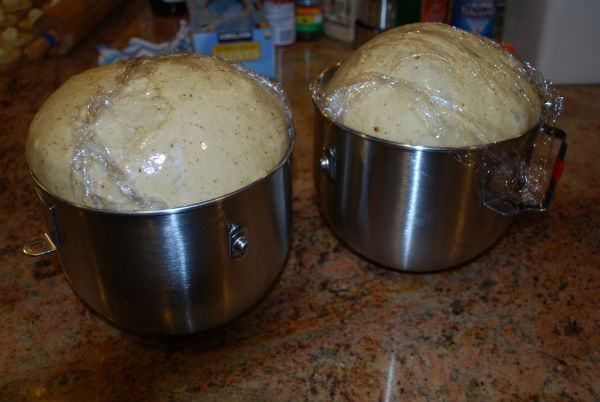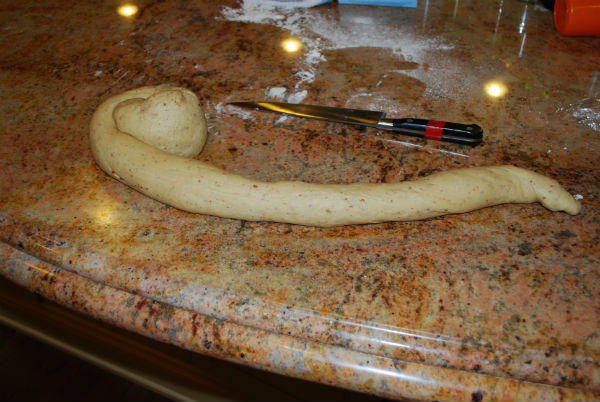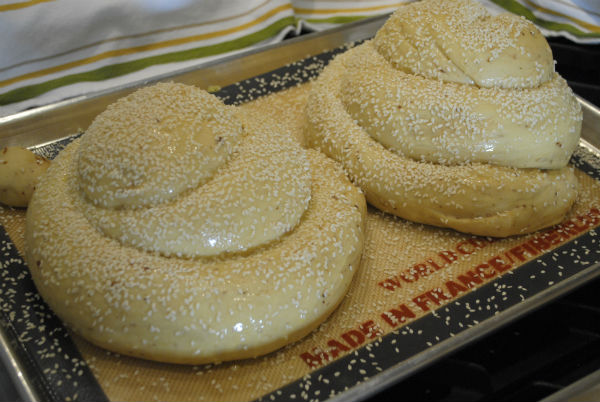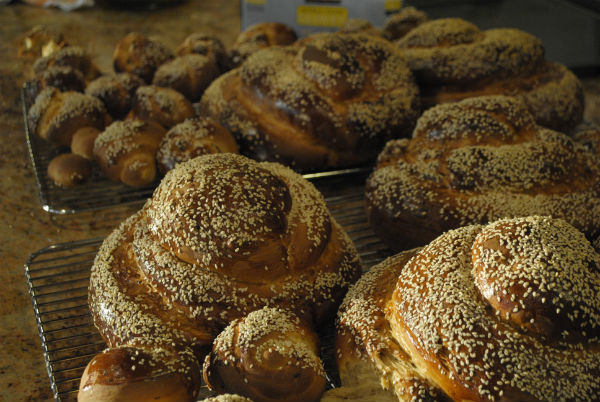Challah is the quintessential Jewish Sabbath and holiday bread. Bread baked from ‘the staff of life’ has a spiritual essence that affirms our connection to the earth’s harvest and sustains us. This Challah is sweet and moist. One recipe makes one huge challah or two medium size challah for Shabbat. On Rosh Hashanah we add raisins for more sweetness. These are coiled breads, which signify the circle of life (beginning with the New Year), instead of the usual braided challah. [1]
[1]
Raisins:
1/ 2 cup raisins, black or Sultanas (golden raisins)
2 cups warm water or enough to cover raisins
Dough:
2 (1/4 ounce) envelopes active dry yeast
1 teaspoon sugar
1 cup warm raisin soaking water
1/3 cup Avocado honey (available at farm markets or specialty food stores, you may substitute any dark honey)
1/2 cup safflower oil
3 extra large eggs, room temperature
6 cups bread flour divided in two (3 cups each) portions
2 teaspoons salt
2 teaspoons ground anise seeds
Topping:
1 egg beaten
1/ 4 cup sesame seeds
Yellow cornmeal for dusting baking sheets
Soak raisins in warm water to rehydrate for about one half hour. Drain raisins well in a sieve over a bowl, retaining 1 cup soaking liquid for later use in bread dough. Spread raisins on paper towels to absorb any excess moisture. Set raisins aside. [2]
[2]
Place yeast in a two cup glass measuring pitcher, add sugar, and then add reserved raisin water. Add honey. When yeast and water are foaming, add oil. Crack eggs in a small bowl. Place 3 cups flour mixture in the work bowl of a large food processor or stand mixer. Pulse flour to blend. Add yeast liquid, and eggs. Process or beat until very smooth. Add additional 3 cups flour and process until a ball forms. For a food processor count 60 seconds while mixing dough. If using a stand mixer knead dough until smooth and elastic. Stop and add reserved raisins, process for another 5 seconds or mix for a few moments, until raisins are distributed throughout dough. Remove dough from processor. The dough should be silky smooth and not hard. If your processor is too small, it may stall out after you add the second 3 cups of flour. In that case remove dough and knead by hand until very smooth and not sticky on a lightly floured work surface.
Place kneaded dough ball in a large bowl and cover with a loose piece of plastic wrap and then a tea towel. Place bowl in warm draft-free place. Let it rise about 1 to 2 hours or until at least doubled in volume (it usually takes 1 and 1/2 to two hours). If you are going to use challah for the blessing take the offering piece now.* Punch dough down, remove it from bowl, and place on a work surface. [3]
[3] [4]
[4]
For two challahs, divide dough in half with a knife. Start with one piece of dough and placing your palms on one end, roll the cylinder or rope longer. It should look like a snake with one end large and bulbous tapering to the opposite end. The rope or cylinder should be about 4 feet long.
With the bulbous end in the center make a tight coil of rope, tucking the last little tale under and pressing to secure it. Repeat with second piece of dough. Place breads carefully on a generous cornmeal dusted baking sheet. Cover breads with a tea towel and let them rise again until double in size, about one hour.
Preheat oven to 350° F. In a small bowl beat egg, and using a light hand, brush carefully onto challah(s). I prefer using a small silicone brush. Sprinkle challah with sesame seeds. Bake 30-35 minutes depending on the size, until dark golden brown. Remove baking sheet from the oven, remove bread from baking sheet, and place on cooling rack to preserve the crisp bottoms.
Sometimes, I make Challahs ahead and freeze them individually wrapped in heavy duty aluminum foil. I reheat them, after defrosting, still wrapped in foil, in a heated oven (350°F) for 10 minutes. They taste freshly made when reheated like this. You can make several batches at once and freeze. [5]
[5]
* The blessing for the separating of the challah is; “Baruch Ata Hashem Elokaynu Melech Haolam Asher Kidshanu B’Mitvotav V’tsivanu L’horfrish Challah” Burn the separated piece in a piece of aluminum foil until no longer edible and discard. Once you do this, you can use the challah bread for blessings. The offering piece should be the size of a golf ball. Check with a rabbi to verify this and use the prayer actually written in Hebrew, not my transliterated version.
9 Comments To "Capeloto Family Challah"
#1 Comment By esther lipsen (varon) On November 17, 2011 @ 4:15 PM
WOULD LIKE RECIPE FOR CHALLAH MADE WITH BREAD MACHINE. I KNOW IT HAS BEEN . THANKS
#2 Comment By Elena Gomez On November 18, 2011 @ 12:16 PM
Hi. I was excited to try this recipe withe the sweet dough and anise. Is it ok to use all purpose flour? 1 cup water seems dry for 6 cups flour even with eggs oil and honey. Is that an estimate? Thank you! Elena
#3 Comment By Linda Capeloto Sendowski On November 19, 2011 @ 4:42 PM
Hi Elena, 1 cup of water is exact, I use extra large eggs and measure the flour carefully. It is OK to use all purpose flour it will just be a little different texture, without long strands so much. I am glad you are going to use the recipe. I make it all of the time.
#4 Comment By Linda Capeloto Sendowski On November 19, 2011 @ 4:44 PM
Hi Esther, I never use a bread machine so I can’t really tell you how to do it. You can make this in a mixer or Cuisinart or by hand. Just be sure to knead it enough.
#5 Comment By Robin Hyman On November 21, 2011 @ 7:35 PM
Linda, has anyone asked you to help them with a high altitude version of your challah. I have tried this recipe here in Denver, CO and it seems the bread is too dense. What do you suggest? Thank you, Robin.
#6 Comment By Linda Capeloto Sendowski On November 25, 2011 @ 11:22 PM
Hi Robin, Since I never really bake at high altitudes I can not give yo first hand experience. I understand that things rise differently and adjustments have to be made in measurements and ratios. I read about a book by Susan Purdy called [6]. Send me a note if it turns out right. Linda
#7 Comment By Norma On August 31, 2013 @ 12:08 PM
Hi Linda,
Made this wonderful challah today. Any tips to prevent the top of the challah from falling down? It fell down before being baked.
I continue to enjoy your blog and wish you, your family and your readers a Happy and Healthy New Year.
Norma
#8 Comment By Linda Capeloto Sendowski On September 2, 2013 @ 4:11 PM
Hi Norma, the only thing I can think of is it must have risen for too long on the second rise after forming the loaves before you put it in the oven. Was your oven totally hot before you put the bread in?
#9 Comment By David On September 11, 2017 @ 8:55 PM
I make a starter with 1/2c deff or rye flour
Avocado oil and agave nectar and 1/4c dried minced onion and nigela seeds with the anise seeds